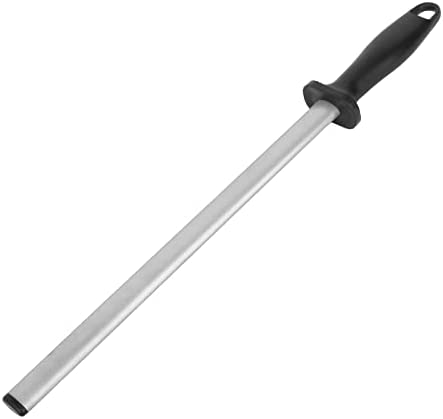
Using a steel rod knife sharpener is an excellent way to keep your knives sharp. However, there are some tips that you need to consider when using a sharpening tool. These include using the correct angle, gauging the proper length, and using a water stone.
Honing a knife’s edge
It’s easy to use a steel rod knife sharpener to get a better edge on your kitchen knives. Basically, it’s all about getting the proper angle. The more you work with a honing rod, the more natural the motion will become.
Using a honing rod to sharpen a knife’s edge will not only give you a good blade, but it can also lengthen the lifespan of your knives. Honing will re-create the edges of your knives, bringing them back to their original shape.
To start with, you’ll want to pick a hone steel that’s a suitable length for your knives. You’ll also need to find one that’s made of a material that won’t bend your edges. These are often steel, but you can also find ceramic or diamond rods.
First, you’ll want to set up your steel rod and a work surface. Ideally, the edge of the rod should be facing down, and the work surface should be clean and dry.
Gauging the correct angle of the honing steel
Gauging the correct angle of the honing steel for a steel rod knife sharpener is a crucial part of keeping your knives in tip top shape. If you don’t hone your knives regularly, they can start to become blunt, which makes it hard to cut food properly.
Luckily, there are a few different ways to find the correct angle. One method involves holding the blade at a 20-degree angle against the honing steel. Then, draw the tip of the blade across the honing steel in a downward arcing motion.
This is a safer method to gauge the correct angle. However, it’s important to remember that too much pressure can damage your knife. A rasping noise means that you are applying too much force.
Once you’ve determined the proper angle, it’s time to hone your knife. There are two types of honing rods: those made of ceramic and those made of steel. Both work well, but the ceramic ones can be harder.
Keeping your knife sharp through regular honing and then sharpening
Honing your knife is an important maintenance task. It not only makes your blades work better, but it also prolongs the life of your knives. Although it is not necessary to hone your knives every day, you should do it once or twice a week.
To hone your knife, you need a good sharpening steel. These are long, narrow rods that are designed to keep the edge of your blade straight. They can be purchased for as little as $40.
When honing a knife, it is important to do it in the correct way. This involves the proper angle, the most effective strokes, and a few other tricks. By following a few simple steps, you can have a sharp knife that works just as well as when it was new.
The simplest method is to place the tip of the blade on the surface of the steel. You can do this by holding it with your hand on the opposite side of the steel.
Using a waterstone for Japanese knives
The Japanese Water Stone is one of the most effective tools to sharpen your kitchen knives. It is easy to use and delivers excellent cutting performance. However, before you get started, there are some things you need to know.
First, you need to choose a stone that is appropriate for your needs. These include natural and synthetic stones. Natural stones are a little more expensive but provide a better finish. Synthetic water stones are cheaper and available in a wide range of grits.
You will need a knife and a stone holder. Before you start, soak your stone in water for five to ten minutes. This will help you maintain the correct angle for sharpening.
Then, press the edge of your knife against the stone. Use the left hand to apply gentle pressure. Press the blade in a downward stroke, and then back away. Your goal is to bring the tip of the blade to the top of the stone.
